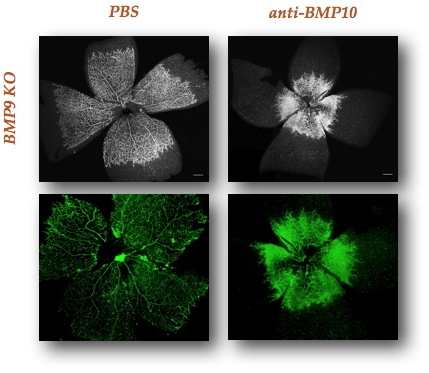Due to its specific expression on endothelial cells, the receptor ALK1 has been recently proposed has a potential therapeutic target in anti-angiogenic treatments of Cancer. A better understanding of its ligands is thus needed for the development of this new therapeutic approach.
In 2007, we were the first to identify the ligands of the orphan receptor ALK1, BMP9 and BMP10. We also showed that BMP9 is present in blood and as such played a role in vascular quiescence. In this work, we now shows in collaboration with two American teams (Thomas Jefferson University, Philadelphia and Johns Hopkins university, Baltimore), that BMP9 knock-out mice treated with an anti-BMP10 neutralising antibody severely affect vascularisation of the retina in new born pups. These results confirm the
in vivo role of BMP9 in angiogenesis and show for the first time the auxiliary role played by BMP10 in this process.
Taken together this works clearly demonstrate for the first time that BMP9 and BMP10 BMP9 are critical in postnatal angiogenesis.

The injection of neutralizing antibody anti-BMP10 inhibits the vascularization of the retina in newborn mice genetically invalidated for BMP9.
Scale bar = 200 µm.